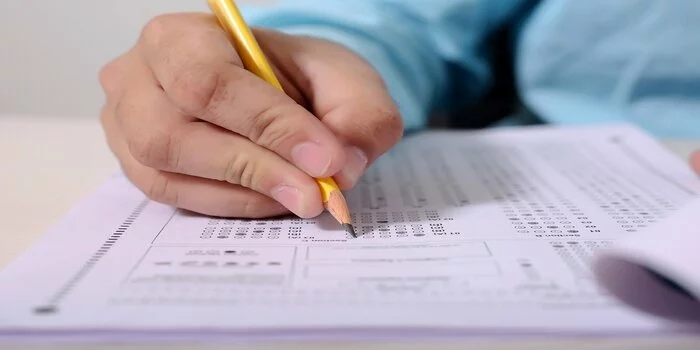MET Exam Pattern 2020 – Manipal Academy of Higher Education (MAHE) will release the exam pattern of MET 2020. The student by consulting MET 2020 exam pattern will get to know about details like, the test will be conducted in computer-based mode, will include MCQs, and that there is negative marking. The MET exam pattern 2020 will thus help the candidate formulate a MET exam preparation 2020 strategy. For example, with objective-type questions asked in the exam, the MET 2020 applicant may focus on speed and accuracy, instead of practicing subject questions. Also, along with the MET exam pattern, it is important that the candidate also consults the MET 2020 syllabus. Go through the rest of the article to learn full details about the MET 2020 exam pattern.
MET Exam Pattern 2020 – Significance
- The exam officials formulates the exam pattern so as to best evaluate the skills they think are essential for the students to succeed in college.
- As per the MET exam pattern, question type will be objective and the candidate has to attempt 200 questions in 150 minutes. This shows that the candidate must have all the formulas in their fingertips and assured in their understanding of various concepts to do well in the MET 2020 exam.
- A unique feature of the MET 2020 question paper is it includes a section on English, which will have 30 questions. Now there are not many B.Tech entrance exams that ask questions on the English subject.
- And among the PCM subjects, Maths carry the maximum weightage as it will contribute 70 questions; Physics and Chemistry each contribute 50 questions.
- All the questions carry the same marks or weightage.
- On a side note, before applying for MET 2020, don’t forget to check out the prescribed eligibility criteria for the exam.
MET Exam Pattern 2020
| Mode of MET 2020 exam | Computer-based test |
| Test duration | 150 minutes |
| Subjects | PhysicsChemistryMathematicsEnglish |
| Total questions | 200 |
| Question type | Multiple Choice Questions (Objective) |
| Subject-wise distribution of questions | Physics – 50Chemistry – 50Mathematics – 70 English – 30 |
| Marking scheme of MET 2020 | +4 for every correct answer -1 for every wrong answer0 for every unanswered question |
| Total marks | 800 |
| Number of attempts | The candidate can appear in MET 2020 (or MU OET 2020) only once. |
| Language of the MET test | English |
Also Read:
MET Eligibility Criteria
Assam CEE 2020
JEE Main 2020
MHT CET 2020
MET Syllabus 2020
The subject-wise topics the candidate has to study for MET 2020 has been given in the table below.
| Subject | MET 2020 syllabus – Topics (or Units) |
| Physics | Units and Measurement, Kinematics, Laws of Motion, Work and Energy, Motion of System of Particles and Rigid Body, Gravitation,Properties of Bulk Matter, Thermodynamics, Behaviour of Perfect Gases and Kinetic Theory of Gases, Oscillations and Waves, Electrostatics, Current Electricity, Magnetic Effects of Current and Magnetism, Electromagnetic Induction and Alternating Currents, Electromagnetic Waves, Optics, Dual Nature of Radiation and Matter. Atoms and Nuclei, Electronic Devices, Communication Systems. Experimental Skills, |
| Chemistry |
Section-A: Physical Chemistry Basic concepts in Chemistry, States of matter, Gaseous stateLiquid state, Atomic structure, Chemical bonding and molecular structure, Ionic bonding, Covalent bonding, Metallic bondingHydrogen bonding, Solutions, Equilibrium involving physical processes:, Equilibrium involving chemical processes, Redox reactions and Electrochemistry, Chemical Kinetics, Surface chemistry, adsorption, Catalysis, Colloids, Chemical thermodynamics, Section – B: Inorganic Chemistry Periodic properties, Principles and processes of metal extractions, Hydrogen, S-block elements, P-block elements, Group 13, Group 14, Group 15, Group 16, Group 17, Group 18, d and f block elements, Lanthanoids, Actinoids, Coordination compounds, Environmental chemistry Section – C: Organic Chemistry Purification and characterization of organic compounds, Basic principles of organic chemistry, Nomenclature, Electronic displacement in a covalent bond, Types of organic reactions, Hydrocarbons, Alkanes, Alkenes, Alkynes, Aromatic hydrocarbons, Organic compounds containing halogens, Organic compounds containing oxygen, Alcohols, Phenols and Ethers:, Alcohols, Phenols, Ethers, Aldehyde and Ketones, Carboxylic acids, Organic compounds containing Nitrogen, Amines, Diazonium salts, Polymers, Biomolecuels, Carbohydrates, Proteins, Vitamins, Nucleic acids, Chemistry in everyday life, Chemicals in medicine, Chemicals in food, Cleansing agents, Principles related to practical chemistry, Chemistry involved in the titrimetric exercises, Chemical principles involved in the qualitative salt analysis |
| Mathematics | Sets, Relations and functions, Trigonometric functions, Inverse trigonometric functions. ALGEBRA Principle of mathematical induction, Complex numbers and quadratic equations, Linear inequalities, Permutations and combinations, Binomial theorem, Sequence and series, Matrices, COORDINATE GEOMETRY, VECTORS AND THREE-DIMENSIONAL GEOMETRY Straight lines, Conic sections, Vectors, Three-dimensional geometry, CALCULUS Limits and derivatives, Continuity and differentiability, Applications of derivatives, Integrals, Applications of the integrals, Differential equations MATHEMATICAL REASONING STATISTICS AND PROBABILITY LINEAR PROGRAMMING |
| English | The test of English Language for the entrance examination covers ‘General English’ of the 10 + 2 standard. It is not designed to evaluate students’ knowledge of English literature, but to test their ability to grasp the fundamental concepts in English grammar and usage. Proficiency in English language is tested through objective-type multiple-choice questions on grammar, vocabulary, sentence correction, synonyms, antonyms, homophones, homonyms, one word substitutions, idioms and phrases,phrasal verbs, and usage. Students are not required to learn the glossary of complicated grammatical jargon, but should have the basic knowledge of word usage, matching of subject and verbs, correct usage of tenses, and grammatically correct sentences acceptable in standard written communication. Tense – Use of proper tense and sequence of tense Modals (have to/had to, must, should, need, ought to and their negative forms) Subject – verb concord Pronouns Sentence structure Usages in English: Commands and requests, Statements, Questions Clauses: Noun clauses, Adverb clauses of condition and time, Relative clauses Determiners/ Use of proper articles Prepositions Vocabulary: Synonyms, Antonyms, Spellings, One word substitutions |





